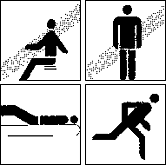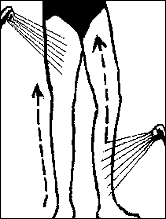
Although venous insufficiency is largely hereditary it is important to keep your veins fit to avoid complications of varicose veins. And this is quite literally true: the walls of  your veins remain elastic if the muscles surrounding them are exercised regularly. This does not mean that you have to be a professional sportsman or sportswoman. A few minutes of targeted venous exercises every day are enough to give your legs a good chance against pronounced venous weakness. If you already have diseased veins and wear compression stockings, it is important to wear them even while performing exercises.
your veins remain elastic if the muscles surrounding them are exercised regularly. This does not mean that you have to be a professional sportsman or sportswoman. A few minutes of targeted venous exercises every day are enough to give your legs a good chance against pronounced venous weakness. If you already have diseased veins and wear compression stockings, it is important to wear them even while performing exercises.
Compression stockings support the affected veins and, by applying mechanical pressure,
ensure the necessary return flow of blood in the veins from the legs back to the heart.  And this is necessary not only for everyday living but also in sport. Particularly for women, it may be of interest to know that compressions tights exert a massage effect during sport on the problem areas of the bottom and thighs, which leads to firming of the tissues. In addition, toning of the muscles in general is promoted by the fact that during sporting activity you are working against the resistance of the stocking.
And this is necessary not only for everyday living but also in sport. Particularly for women, it may be of interest to know that compressions tights exert a massage effect during sport on the problem areas of the bottom and thighs, which leads to firming of the tissues. In addition, toning of the muscles in general is promoted by the fact that during sporting activity you are working against the resistance of the stocking.
People with spider veins and mild to moderate varicose veins can in principle practice any type of exercise. One exception is extreme bodybuilding, as this puts an additional strain on the veins. Particular suitable sports include hiking, power walking
(also Nordic walking with poles), cycling, cross-country skiing, inline skating (here poles can be used to simulate the skating technique from cross-country skiing), aqua jogging, swimming, dancing, golf, fitness training on endurance equipment (e.g. stepper, cross trainer, bicycle ergometer) or special vein exercises.
(here poles can be used to simulate the skating technique from cross-country skiing), aqua jogging, swimming, dancing, golf, fitness training on endurance equipment (e.g. stepper, cross trainer, bicycle ergometer) or special vein exercises.
People with pronounced varicose veins, a history of thrombosis (venous occlusion) or phlebitis (inflammation of the veins) must be more cautious in choosing their exercise. Sports that can be considered particularly suitable are power walking, hiking, cycling, golf, dancing, swimming, aqua-aerobics or aqua jogging and in the winter cross-country skiing. All kinds of sports involving the development of high strength and abrupt stopping movements must be avoided. These include bodybuilding but also jogging, high-impact aerobics, badminton, handball or football. Skiing and snowboarding are also unsuitable.
Those who want to relax in the sauna after sporting activity should keep in mind that the feet should be kept up in the sauna and restroom, and that the legs should be thoroughly showered with cold water after each visit to the sauna. For patients with deep vein thrombosis, however, the sauna is to be avoided.
Exercise program |
1 – Standing position: |
|
2 – Exercises in the sitting position: |
|
3 – Exercises lying down: |
|